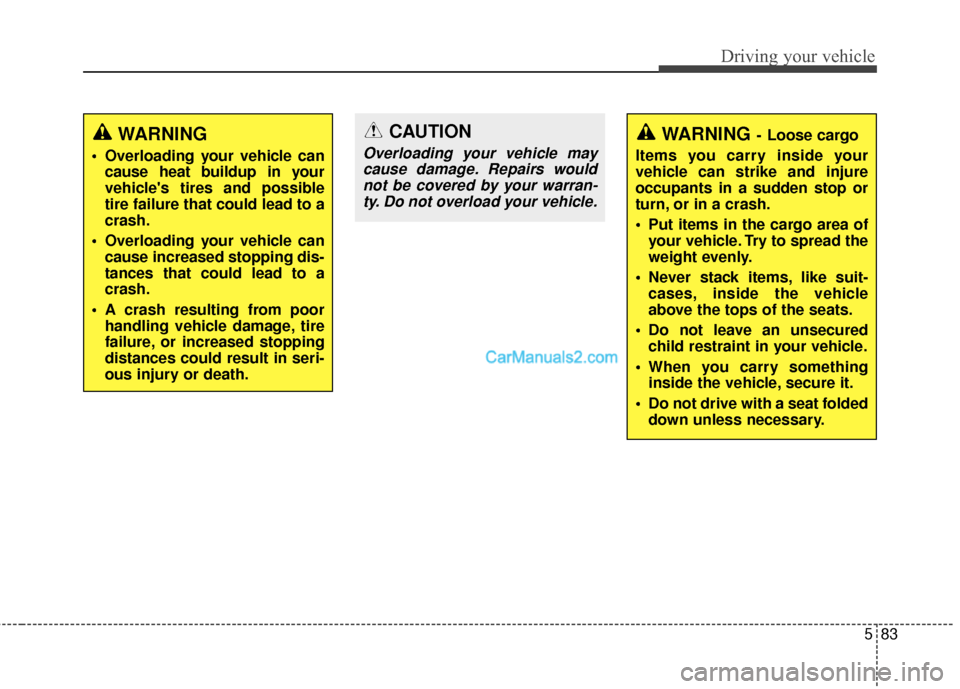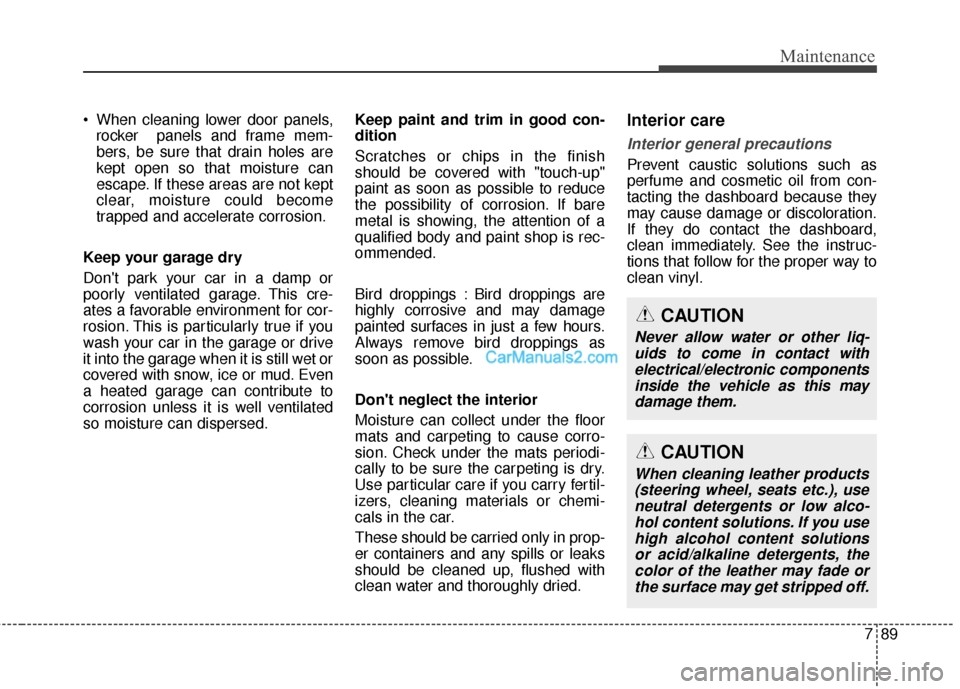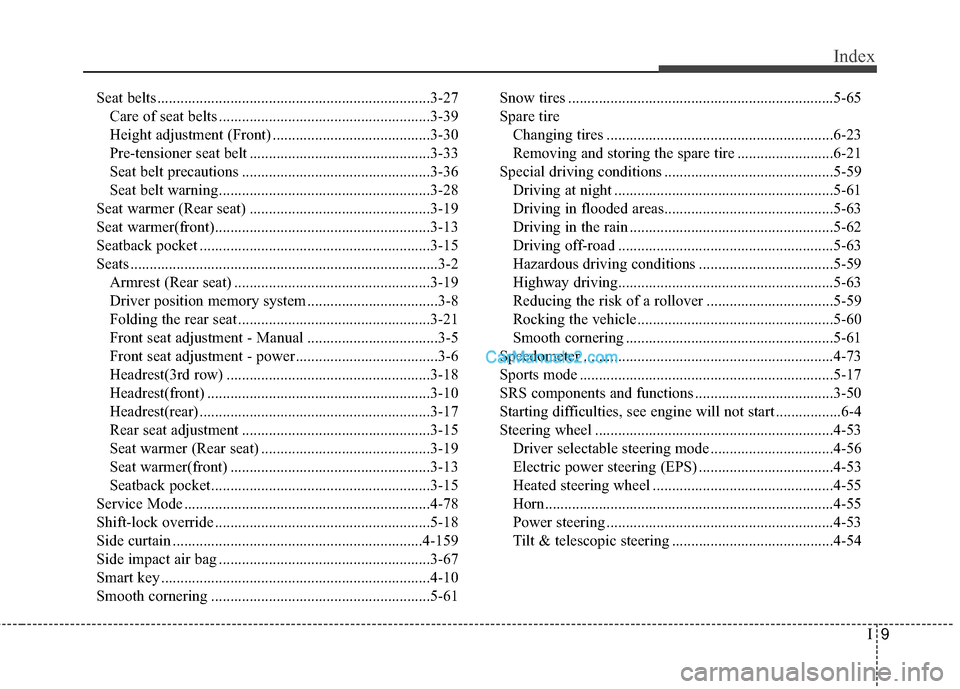2016 Hyundai Santa Fe seats
[x] Cancel search: seatsPage 97 of 759

377
Safety features of your vehicle
Never hold an infant or child on
your lap. The infant or child could
be seriously injured or killed in the
event of a crash. All infants and chil-
dren should be properly restrained
in appropriate child safety seats or
seat belts in the rear seat.
Adding equipment to or modi-
fying your air bag-equipped
vehicle
If you modify your vehicle by chang-
ing your vehicle's frame, bumper sys-
tem, front end or side sheet metal or
ride height, this may affect the oper-
ation of your vehicle's air bag sys-
tem.
Air bag warning label
Air bag warning labels, some required
by the U.S. National Highway Traffic
Safety Administration (NHTSA), are
attached to alert the driver and pas-
sengers of potential risks of the air
bag system.
WARNING
Sitting improperly or out of position can cause occupants
to be shifted too close to a
deploying air bag, strike the
interior structure or be thrown
from the vehicle resulting in
serious injury or death.
Always sit upright with the seatback in an upright posi-
tion, centered on the seat
cushion with your seat belt
on, legs comfortably extended
and your feet on the floor.
(Continued)
(Continued)
Always have the ignition OFFwhen the vehicle is being
towed or where it may other-
wise be tilted, since the side
and/or curtain air bags may
inflate if the sensors interpret
those tilt angles as a potential
rollover.
Be careful not to cause impact to the doors when the ignition
is ON. The air bags may inflate.
OANNSA2006
ODM032057
Page 608 of 759

583
Driving your vehicle
WARNING
Overloading your vehicle cancause heat buildup in your
vehicle's tires and possible
tire failure that could lead to a
crash.
Overloading your vehicle can cause increased stopping dis-
tances that could lead to a
crash.
A crash resulting from poor handling vehicle damage, tire
failure, or increased stopping
distances could result in seri-
ous injury or death.
WARNING - Loose cargo
Items you carry inside your
vehicle can strike and injure
occupants in a sudden stop or
turn, or in a crash.
Put items in the cargo area of your vehicle. Try to spread the
weight evenly.
Never stack items, like suit- cases, inside the vehicle
above the tops of the seats.
Do not leave an unsecured child restraint in your vehicle.
When you carry something inside the vehicle, secure it.
Do not drive with a seat folded down unless necessary.CAUTION
Overloading your vehicle maycause damage. Repairs wouldnot be covered by your warran-ty. Do not overload your vehicle.
Page 700 of 759

Maintenance
58
7
Tire terminology and definitions
Air Pressure: The amount of air
inside the tire pressing outward on
the tire. Air pressure is expressed in
pounds per square inch (psi) or kilo-
pascal (kPa).
Accessory Weight: This means the
combined weight of optional acces-
sories. Some examples of optional
accessories are, automatic transaxle
power seats, and air conditioning.
Aspect Ratio: The relationship of a
tire's height to its width.
Belt: A rubber coated layer of cords
that is located between the plies and
the tread. Cords may be made from
steel or other reinforcing materials.
Bead: The tire bead contains steel
wires wrapped by steel cords that
hold the tire onto the rim.
Bias Ply Tire: A pneumatic tire in
which the plies are laid at alternate
angles less than 90 degrees to the
centerline of the tread.
Cold Tire Pressure: The amount of
air pressure in a tire, measured in
pounds per square inch (psi) or kilo-
pascals (kPa) before a tire has built
up heat from driving. Curb Weight:
This means the weight
of a motor vehicle with standard and
optional equipment including the
maximum capacity of fuel, oil and
coolant, but without passengers and
cargo.
DOT Markings: A code molded into
the sidewall of a tire signifying that
the tire is in compliance with the U.S.
Department of Transportation motor
vehicle safety standards. The DOT
code includes the Tire Identification
Number (TIN), an alphanumeric des-
ignator which can also identify the
tire manufacturer, production plant,
brand and date of production.
GVWR: Gross Vehicle Weight Rating
GAWR FRT: Gross Axle Weight
Rating for the Front Axle.
GAWR RR: Gross Axle Weight
Rating for the Rear axle.
Intended Outboard Sidewall: The
side of an asymmetrical tire, that
must always face outward when
mounted on a vehicle.
Kilopascal (kPa): The metric unit for
air pressure. Light truck(LT) tire:
A tire designat-
ed by its manufacturer as primarily
intended for use on lightweight trucks
or multipurpose passenger vehicles.
Load ratings: The maximum load
that a tire is rated to carry for a given
inflation pressure.
Load Index: An assigned number
ranging from 1 to 279 that corre-
sponds to the load carrying capacity
of a tire.
Maximum Inflation Pressure: The
maximum air pressure to which a
cold tire may be inflated. The maxi-
mum air pressure is molded onto the
sidewall.
Maximum Load Rating: The load
rating for a tire at the maximum per-
missible inflation pressure for that
tire.
Maximum Loaded Vehicle Weight:
The sum of curb weight; accessory
weight; vehicle capacity weight; and
production options weight.
Normal Occupant Weight: The
number of occupants a vehicle is
designed to seat multiplied by 150
pounds (68 kg).
Page 731 of 759

789
Maintenance
When cleaning lower door panels,rocker panels and frame mem-
bers, be sure that drain holes are
kept open so that moisture can
escape. If these areas are not kept
clear, moisture could become
trapped and accelerate corrosion.
Keep your garage dry
Don't park your car in a damp or
poorly ventilated garage. This cre-
ates a favorable environment for cor-
rosion. This is particularly true if you
wash your car in the garage or drive
it into the garage when it is still wet or
covered with snow, ice or mud. Even
a heated garage can contribute to
corrosion unless it is well ventilated
so moisture can dispersed. Keep paint and trim in good con-
dition
Scratches or chips in the finish
should be covered with "touch-up"
paint as soon as possible to reduce
the possibility of corrosion. If bare
metal is showing, the attention of a
qualified body and paint shop is rec-
ommended.
Bird droppings : Bird droppings are
highly corrosive and may damage
painted surfaces in just a few hours.
Always remove bird droppings as
soon as possible.
Don't neglect the interior
Moisture can collect under the floor
mats and carpeting to cause corro-
sion. Check under the mats periodi-
cally to be sure the carpeting is dry.
Use particular care if you carry fertil-
izers, cleaning materials or chemi-
cals in the car.
These should be carried only in prop-
er containers and any spills or leaks
should be cleaned up, flushed with
clean water and thoroughly dried.Interior care
Interior general precautions
Prevent caustic solutions such as
perfume and cosmetic oil from con-
tacting the dashboard because they
may cause damage or discoloration.
If they do contact the dashboard,
clean immediately. See the instruc-
tions that follow for the proper way to
clean vinyl.
CAUTION
Never allow water or other liq-
uids to come in contact withelectrical/electronic componentsinside the vehicle as this maydamage them.
CAUTION
When cleaning leather products(steering wheel, seats etc.), useneutral detergents or low alco-hol content solutions. If you usehigh alcohol content solutionsor acid/alkaline detergents, thecolor of the leather may fade orthe surface may get stripped off.
Page 757 of 759

I9
Index
Seat belts .......................................................................3\
-27Care of seat belts .......................................................3-39
Height adjustment (Front) .........................................3-30
Pre-tensioner seat belt ...............................................3-33
Seat belt precautions .................................................3-36
Seat belt warning.......................................................3-28
Seat warmer (Rear seat) ...............................................3-19
Seat warmer(front)........................................................3-13
Seatback pocket ............................................................3-15
Seats ........................................................................\
........3-2 Armrest (Rear seat) ...................................................3-19
Driver position memory system ..................................3-8
Folding the rear seat ..................................................3-21
Front seat adjustment - Manual ..................................3-5
Front seat adjustment - power .....................................3-6
Headrest(3rd row) .....................................................3-18
Headrest(front) ..........................................................3-10
Headrest(rear) ............................................................3-17
Rear seat adjustment .................................................3-15
Seat warmer (Rear seat) ............................................3-19
Seat warmer(front) ....................................................3-13
Seatback pocket.........................................................3-15
Service Mode ................................................................4-78
Shift-lock override ........................................................5-18
Side curtain .................................................................4-159
Side impact air bag .......................................................3-67
Smart key ......................................................................4-\
10
Smooth cornering .........................................................5-61 Snow tires .....................................................................5-6\
5
Spare tire
Changing tires ...........................................................6-23
Removing and storing the spare tire .........................6-21
Special driving conditions ............................................5-59 Driving at night .........................................................5-61
Driving in flooded areas............................................5-63
Driving in the rain .....................................................5-62
Driving off-road ........................................................5-63
Hazardous driving conditions ...................................5-59
Highway driving........................................................5-63
Reducing the risk of a rollover .................................5-59
Rocking the vehicle...................................................5-60
Smooth cornering ......................................................5-61
Speedometer .................................................................4-73
Sports mode ..................................................................5-17
SRS components and functions ....................................3-50
Starting difficulties, see engine will not start .................6-4
Steering wheel ..............................................................4-53 Driver selectable steering mode ................................4-56
Electric power steering (EPS) ...................................4-53
Heated steering wheel ...............................................4-55
Horn........................................................................\
...4-55
Power steering ...........................................................4-53
Tilt & telescopic steering ..........................................4-54